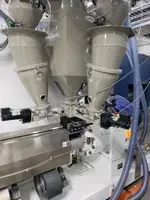Web Metal Detector
![]()
| Materials: | Plastic film, paper, textiles, woven fabrics, nonwoven materials, and other non-metallic web materials |
| Detects: | Ferrous, non-ferrous, and stainless steel |
| Applications |
Film converting, packaging, printing, laminating, and coating lines |


Web Metal Detectors
Bunting Web Metal Detectors provide continuous, high-sensitivity inspection of thin, non-metallic materials such as plastic film, paper, textiles, woven fabrics, and nonwoven materials. Installed directly in-line, they detect ferrous, non-ferrous, and stainless steel contaminants without interrupting production. Ideal for packaging, printing, laminating, film converting, and textile processing, these systems protect rollers, slitters, and downstream equipment from damage while ensuring consistent product quality and reliable inspection performance.
- About
- Benefits
- Applications
- How They Work
Bunting Web Metal Detectors are designed for continuous inspection of thin, non-metallic web materials such as plastic film, foil, paper, textiles, woven fabrics, nonwoven materials, and laminates. Installed in-line on web processing equipment, they provide precise detection of ferrous, non-ferrous, and stainless steel contaminants before they can damage rollers, slitters, or downstream converting machinery.
With their slim, modular design, Web Metal Detectors integrate easily into both new and existing production lines. They monitor the entire web width in real time, ensuring full-surface coverage without interrupting product flow. Adjustable sensitivity and advanced signal processing deliver reliable, high-speed performance even on wide or fast-moving webs.
By preventing metal contamination, Web Metal Detectors protect valuable equipment, maintain consistent product quality, and safeguard brand reputation. Their accuracy and repeatability make them an essential part of quality assurance programs across packaging, film converting, and laminating operations, helping manufacturers reduce waste, avoid customer complaints, and meet strict industry standards.
High-Sensitivity Metal Detection
Detects ferrous, non-ferrous, and stainless steel contaminants in film, foil, paper, textile, woven, and nonwoven web-based materials.
Continuous Inline Inspection
Monitors the entire web width in real time without interrupting product flow, ensuring complete inspection across every roll.
Protects Equipment and Brand Reputation
Prevents damage to slitters, laminators, and rollers while maintaining consistent product quality and protecting brand trust.
Supports Quality Assurance Programs
Delivers reliable, repeatable detection performance that helps meet strict QA and process control standards.
Compact, Retrofit-Friendly Design
Slim, modular construction fits easily into both new and existing converting, printing, or laminating lines.
Customizable Sensitivity and Calibration
Allows operators to fine-tune detection performance for different web thicknesses, material types, and line speeds.
Low-Maintenance Reliability
Built for continuous operation in high-speed production environments with minimal service requirements.
Web Metal Detectors are used in industries where thin, continuous materials such as film, foil, paper, textiles, woven, and nonwoven fabrics are processed, converted, or finished. They help manufacturers prevent costly downtime, ensure consistent product quality, and protect brand reputation.
Film and Foil Converting
Used in plastic film, and laminate production to detect metal contaminants that can cause surface defects or damage downstream equipment.
Printing and Laminating Lines
Installed before slitters or coaters to identify contaminants early in the process, preventing rework, waste, and customer complaints.
Paper and Textile Manufacturing
Inspect paper sheets, fiber webs, and nonwoven fabrics to safeguard cutting and winding systems from metal contamination.
Packaging and Flexible Materials
Ensures high-quality, contaminant-free film used in food, pharmaceutical, and consumer packaging applications.
Recycling and Recovered Materials
Applied in recycling processes where web-based films and fibers are reprocessed, ensuring metal-free output that meets quality and safety standards.
Textiles and Nonwoven Production
Inspect woven and nonwoven fabrics used in filtration, hygiene, and industrial textile manufacturing to prevent contamination and protect downstream processing equipment.
By detecting contaminants early, Web Metal Detectors strengthen quality assurance programs, extend equipment life, and protect both production efficiency and brand integrity.
Web Metal Detectors are installed in-line with the moving web or sheet material, providing continuous inspection throughout production. As the web passes through the detection coil, the system scans for ferrous, non-ferrous, and stainless steel contaminants across the full material width.
When metal is detected, the coil generates a signal that is processed by the control unit. The system can alert operators, mark the contaminated area, or stop the line to prevent the defect from reaching downstream processes.
Designed for real-time monitoring, Web Metal Detectors deliver precise, high-speed detection without disrupting production. By identifying contamination before it reaches slitting, coating, or packaging stages, they help prevent waste, maintain consistent quality, and support brand protection through reliable, verifiable inspection.
FAQ's
A Web Metal Detector is an inline inspection system used to detect metal contamination in thin, continuous materials such as plastic film, paper, and textiles. Installed directly on converting, laminating, or printing lines, it scans the entire web width to identify ferrous, non-ferrous, and stainless steel contaminants before they can damage downstream equipment or affect product quality.
By detecting even small pieces of metal within the web, these systems prevent contaminants from damaging rollers, slitters, laminators, and coating machines. This helps extend equipment life, reduce maintenance costs, and minimize downtime.
They provide consistent, high-sensitivity detection that ensures each roll or web is free from metal contamination. This verification helps manufacturers maintain strict QA standards, reduce customer complaints, and protect brand reputation through reliable, documented inspection.
They are suitable for inspecting plastic film, paper, nonwoven fabrics, textiles, laminates, and coated materials. Their sensitivity can be adjusted to suit different material types, web thicknesses, and production speeds.
Yes. Web Metal Detectors feature slim, modular construction that allows easy integration into both new and existing converting, printing, or laminating lines without major modifications.
When metal is detected, the system sends a signal to the control unit, which can activate an alarm, mark the contaminated section, or stop the line. This enables precise removal of the affected material before further processing.
Yes. They are engineered for continuous, high-speed inspection and can handle fast-moving webs without sacrificing accuracy or sensitivity.
Application Photos








Talk to an Application Engineer
Not sure what you need? Let’s talk through your application and identify the right solution.

